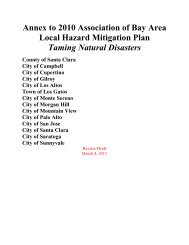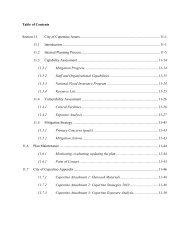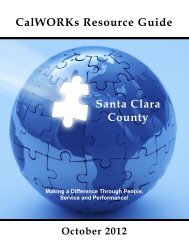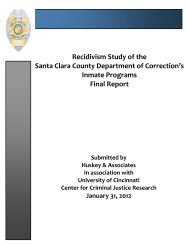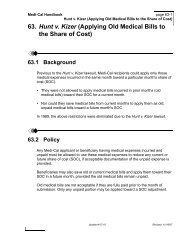Through Their Eyes: Domestic Violence and It's Impact on Children
Through Their Eyes: Domestic Violence and It's Impact on Children
Through Their Eyes: Domestic Violence and It's Impact on Children
Create successful ePaper yourself
Turn your PDF publications into a flip-book with our unique Google optimized e-Paper software.
Chapter 1<br />
refusing to talk about the abuse.<br />
Mothers may try to protect their<br />
children from the trauma of the<br />
violence by denying that anything<br />
bad has happened or minimizing the<br />
severity. This sends the message that<br />
children cannot or should not talk<br />
about what they<br />
have<br />
seen or heard.<br />
It may also change their view of the<br />
situati<strong>on</strong>, <str<strong>on</strong>g>and</str<strong>on</strong>g> lead to c<strong>on</strong>fusi<strong>on</strong>.<br />
Without an outlet to discuss the<br />
incident(s), children may draw their<br />
own c<strong>on</strong>clusi<strong>on</strong>s, which can often<br />
include self-blame or blame of the<br />
mother. Sadly, this is exactly what<br />
mothers are trying to avoid in the<br />
first place, <str<strong>on</strong>g>and</str<strong>on</strong>g> it fits neatly into the<br />
batterer’s agenda.<br />
Parents often think their children<br />
do not know that the violence is<br />
occurring. But children are almost<br />
always aware of abusive behavior that<br />
is happening in the home. They come<br />
in c<strong>on</strong>tact with it through a variety of<br />
ways, both directly <str<strong>on</strong>g>and</str<strong>on</strong>g> indirectly.<br />
They always notice the<br />
tensi<strong>on</strong> that is present in<br />
their home —a “walking<br />
<strong>on</strong> eggshells” feeling.<br />
They worry, they<br />
try to please, <str<strong>on</strong>g>and</str<strong>on</strong>g><br />
they often try to<br />
“fix” the problem<br />
in order to avoid<br />
a blow-up. If<br />
there is more<br />
than <strong>on</strong>e child,<br />
children may talk<br />
about it am<strong>on</strong>g<br />
themselves. The<br />
media often shows<br />
us the image of a<br />
younger child crawling<br />
into bed to seek<br />
comfort <str<strong>on</strong>g>and</str<strong>on</strong>g> reassurance<br />
from an older child.<br />
When an incident happens,<br />
children are often visual witnesses.<br />
They may see slapping, punching,<br />
hitting, or other physical abuse<br />
toward their mother, or they may<br />
witness loud arguments <str<strong>on</strong>g>and</str<strong>on</strong>g> explosive<br />
outbursts directed at inanimate<br />
objects. In some instances, children<br />
try to intervene, often to protect their<br />
mother, <str<strong>on</strong>g>and</str<strong>on</strong>g> are injured in the process.<br />
The Minnesota<br />
Center Against<br />
<str<strong>on</strong>g>Violence</str<strong>on</strong>g> <str<strong>on</strong>g>and</str<strong>on</strong>g> Abuse’s<br />
“Child Involvement<br />
Survey” looked at<br />
how children became<br />
involved in domestic<br />
violence incidents in<br />
the home, even when<br />
they are not direct<br />
victims of violence.<br />
The results showed<br />
overwhelming<br />
evidence that<br />
domestic violence<br />
does not c<strong>on</strong>fine<br />
itself to the partner<br />
relati<strong>on</strong>ship.<br />
6






